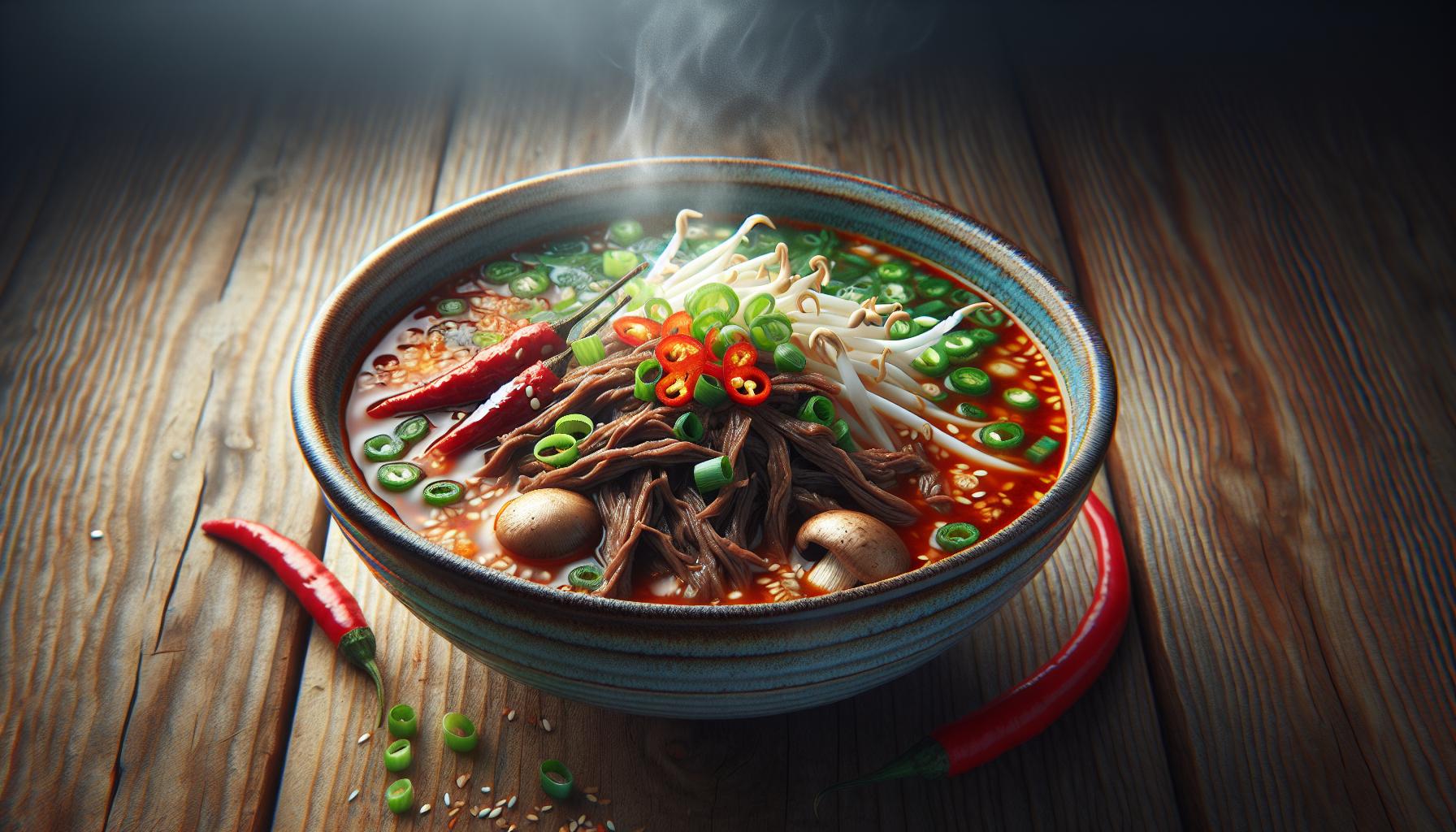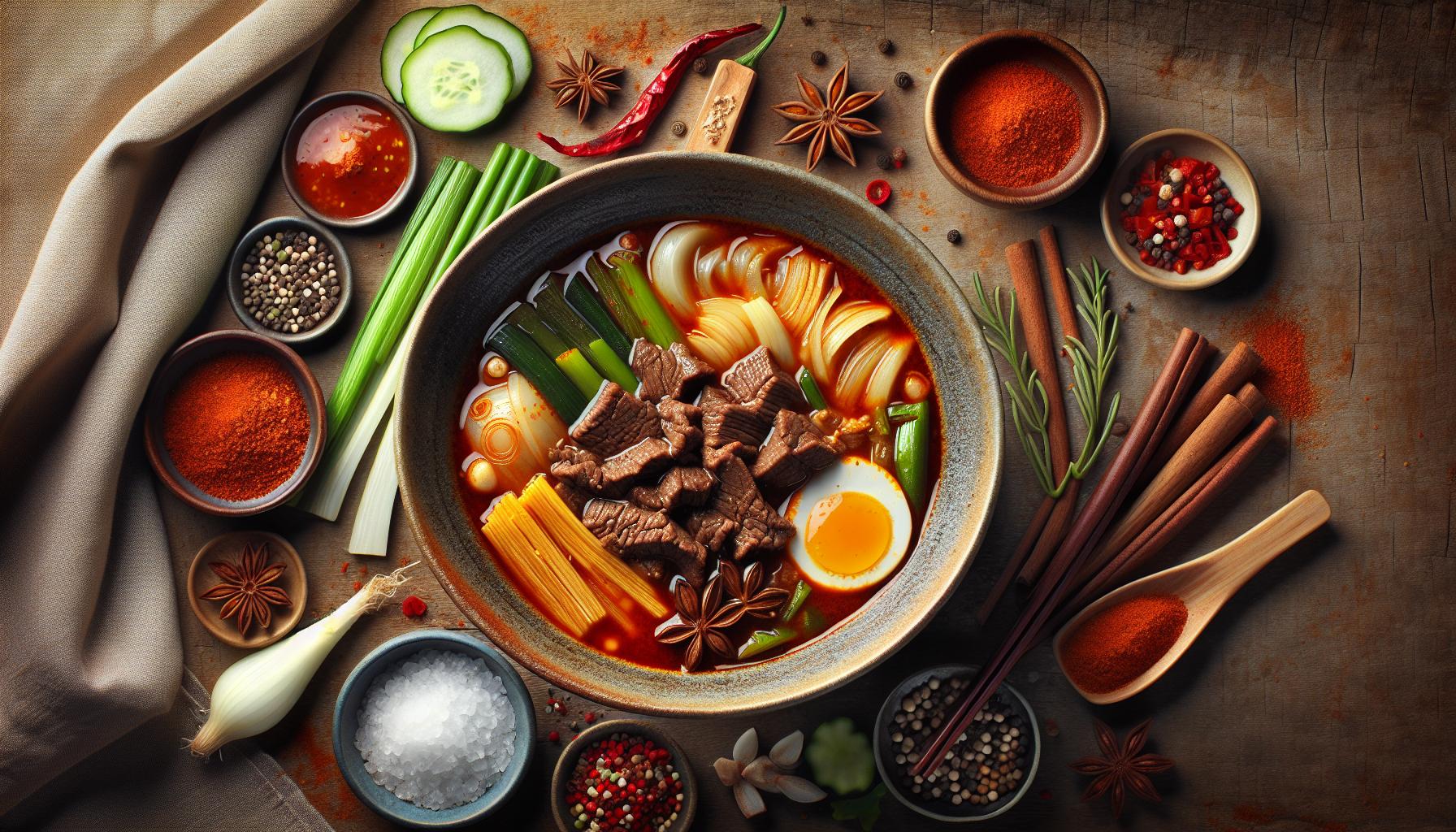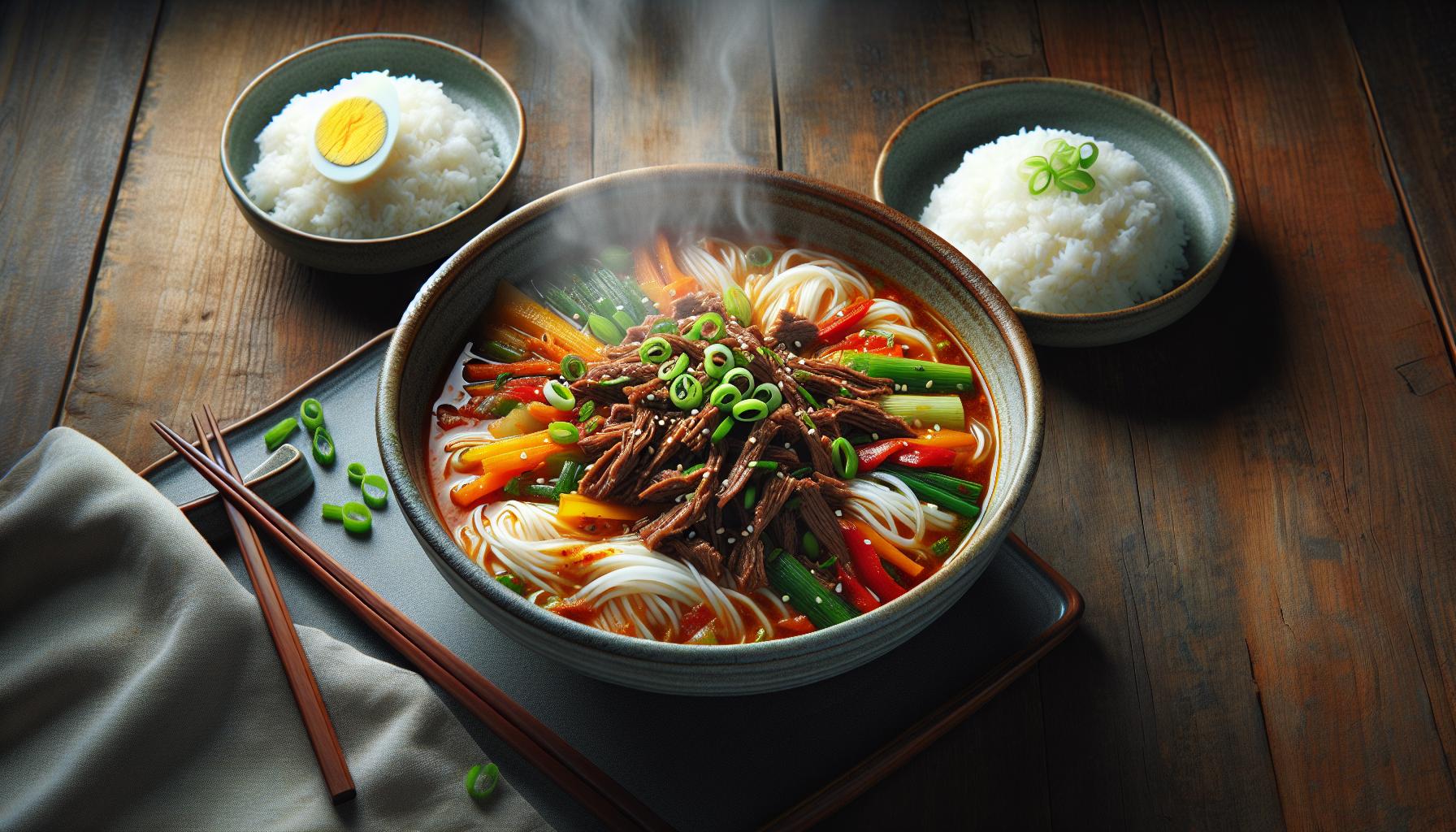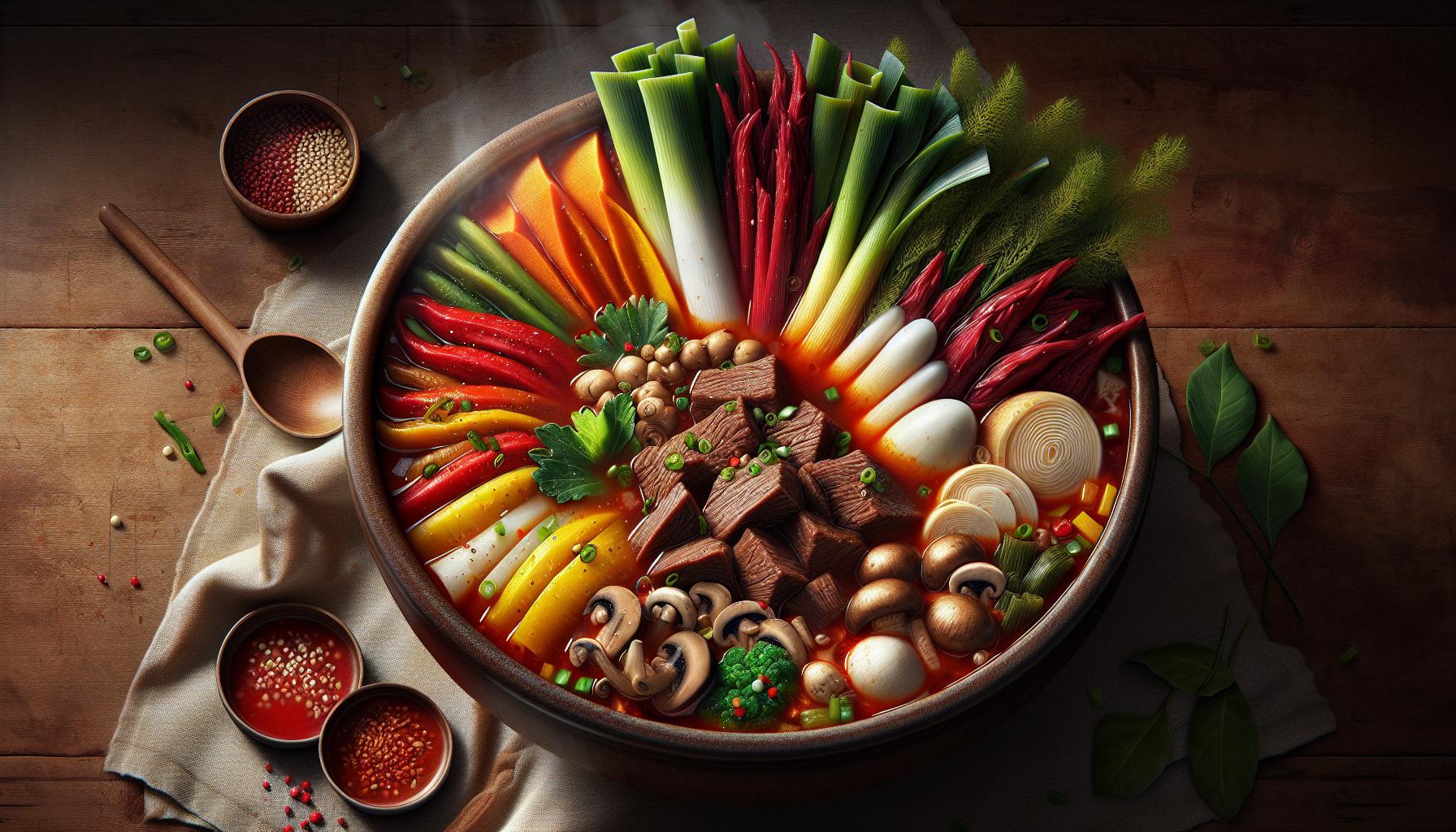Ingredients for Homemade Yukgaejang
Kickstart your culinary journey into Korean cuisine with yukgaejang, a hearty spicy beef soup loaded with vegetables. Here’s a list of ingredients to get you started.
To serve 4 people, you’ll need:
1 pound of beef brisket, a rich, flavorful cut that cooks to tender perfection. 5 dried shiitake mushrooms soaked in water will add a dash of umami.
In terms of an aromatics bundle, prepare the following:
- 2 cloves of garlic
- half an onion
- 1 thumb-sized piece of ginger
You’ll also need 5 green onions cut into finger lengths and 3 Korean red chili peppers. For a milder heat, deseed them.
Moving onto the veggies, you’ll want:
- 2 cups of bean sprouts
- 2 cups of taro stems (Toran). If you can’t find taro stems, substitute them with potato or bok choy. Both alternatives give your soup a unique twist!
To build your broth, get hold of 8 cups of water.
Finally, for seasoning, gather these:
- 3 tbsp of soy sauce
- 1.5 tbsp of red pepper powder (Gochugaru)
- 1 tsp of sesame oil
- Salt to taste
Here’s a summary with all measures:
| Ingredient | Amount |
|---|---|
| Beef brisket | 1 pound |
| Dried mushrooms | 5 |
| Garlic | 2 cloves |
| Onion | 1/2 |
| Ginger | 1 thumb-sized |
| Green onions | 5, finger length |
| Red chili peppers | 3, deseeded |
| Bean sprouts | 2 cups |
| Taro stems | 2 cups |
| Water | 8 cups |
| Soy sauce | 3 tbsp |
| Red pepper powder | 1.5 tbsp |
| Sesame oil | 1 tsp |
| Salt | To taste |
Now that your pantry’s stocked, let’s dive into the next step on your yukgaejang adventure: the cooking process.
Step-by-Step Cooking Instructions

Here’s your roadmap to making a savory, homemade yukgaejang.
Step 1: The first step in your yukgaejang journey starts in the kitchen. Rinse your brisket under cold water to wash out residual blood. Then, boil your brisket in a large pot filled with water for about an hour.
Step 2: While your brisket is boiling, soak your dried shiitake mushrooms in a separate bowl of water. It’s to rehydrate them and acquire the earthy flavor they are renowned for.
Step 3: In a blazing-hot pan, sauté your aromatics (garlic, onion, and ginger). Do this until you’re greeted with a golden-brown hue and an irresistible aroma. Be mindful not to burn them.
Step 4: Back to your boiled brisket. Remove it from the heat, and let it cool down. Once it’s cooled, shred it into bite-sized pieces. Hold onto that flavorful broth – you’re going to need it!
Step 5: This is where the heat gets turned up. In the same pot, add your shredded brisket, sautéed aromatics, and Korean red chili peppers. Now, pour in that brisket broth and bring to a boil.
Step 6: Add your drained and squeezed mushrooms, bean sprouts, and taro stems. If you don’t have taro stems, no problem – potato or bok choy work as great substitutes.
Step 7: Season your soup with soy sauce, red pepper powder, sesame oil, and salt till your tastebuds sing.
There you have it – your yukgaejang is ready to be dished up and devoured. However, for an extra kick, allow it to simmer for a couple more hours, paving the path for the flavors to truly meld together.
Bon Appétit! Keep in mind that authentic Korean dishes rely heavily on the balance of flavors. It’s okay to tweak the recipe to suit your preference. In fact, it’s encouraged! Whichever route you take, the result is bound to be delicious. Now, who’s ready for a comforting bowl of yukgaejang beef soup?
Tips for Perfecting the Spice Level

Getting that perfect spice level in your homemade yukgaejang isn’t rocket science. It’s about balancing the heat to suit your preferences.
Start off by tasting your Korean red chili peppers. Remember, the size and color of these peppers aren’t always an indication of their heat. Each pepper’s spice level can vary significantly, so it’s best to taste a tiny bit to get the idea of its heat.
To control the words of the wise, you should add the red chili pepper in increments before cooking. Taste your soup as you go along. You can always add more, but it’s pretty hard – if not impossible – to take the spice out once it’s mixed in. This step is crucial as too much spice might overpower the subtle flavors of the beef and other ingredients, dousing the balanced flavor profile you’re aiming for.
Even after all your cautionary steps, if your soup turns out a bit too spicy, don’t despair – you still have options. Dairy products such as cream, milk, or unsweetened yogurt can help temper the chili’s heat. A spoonful of sugar or a dash of vinegar can also help balance things out. Rice is another great option that not only helps in soothing the fire but also enhances your soup’s consistency.
Serving and Garnishing Your Yukgaejang

After simmering to perfection, your yukgaejang is nearly ready to delight those taste buds. But hold on, there’s more to this gastronomic journey. Close attention to serving and garnishing your yukgaejang might just turn your good soup into a great one. It’s time to draw some inspiration from the Korean tradition of thoughtfully and artistically plating food. And don’t worry, your flavor-packed yukgaejang is bound to shine no matter what.
First, let’s talk about what goes into an ideal serving of yukgaejang. For a balanced meal, aim for:
| Component | Value |
|---|---|
| Meat & Broth | 40% |
| Vegetables | 35% |
| Rice/Noodles | 25% |
Serving tip: Remember, yukgaejang is typically served with a bowl of rice on the side. Not only adds a lovely texture but also balances the heat.
Now let’s delve into garnishing. A little creativity here goes long way. Here’re a few pointers:
- Freshly chopped scallions or leeks add a pop of color and a refreshing crunch.
- Another coveted garnish in Korean cuisine is julienned egg omelette.
- Don’t shy away from sprinkling sesame seeds that add a subtle nutty flavor and texture.
Health Benefits of Yukgaejang

Diving into the health benefits, yukgaejang packs a nutritious punch. Largely composed of protein-rich beef and a variety of vegetables, it’s a balanced dish that contributes significantly to your daily nutrient intake.
Yukgaejang, a spicy beef soup, is filled with protein. Protein serves as the foundation of every cell in your body. From repairing tissues to forming the blocks of muscles, bones, and skin – you require protein in your diet. Additionally, your body utilizes protein to implicitly make enzymes, hormones, and other body chemicals.
To understand the dietary composition of yukgaejang even more, let’s break down its values in a simple markdown table:
| Nutritional Components | Typical Values per Serving |
|---|---|
| Calories | 275 |
| Protein | 20g |
| Carbs | 16g |
| Fat | 10g |
| Fiber | 2g |
As you can see, yukgaejang has a good balance of macronutrients with a moderate amount of healthy fats and carbs.
Yukgaejang isn’t just about beef – you’ll find a profusion of vegetables in this soup. Red peppers pack a dose of vitamin C while scallions and leeks introduce vitamin A into the mix. This combination not only enhances the flavor but also boosts the nutrient profile of your dish.
Fiber merits a special mention here. Fiber, particularly in the vegetables and mushrooms of yukgaejang, helps regulate your body’s use of sugars, thereby keeping your hunger and blood sugar in check.
Not forgetting, yukgaejang is made with gosari, or fernbrake, famous for its antioxidant properties. It helps flush out unwanted toxins and reduce inflammation – paving the way to enhanced overall health.
Delightful to palate and healthy at heart, yukgaejang is nutritionally rich. Incorporating this Korean dish into your diet can make for a hearty and beneficial meal. Gradually, as you get the knack for making yukgaejang at home, you’ll find out that it’s a perfect fit for any season or meal of the day.
Conclusion
So there you have it. Yukgaejang isn’t just a burst of savory flavors to your palate, but it’s also a powerhouse of nutrition. It’s a perfect blend of protein from the beef and a variety of vitamins from the vegetables. This spicy beef soup doesn’t just satisfy your taste buds, but it also caters to your body’s needs. The gosari adds a unique antioxidant touch, cleansing your body. With its balanced macronutrients, it’s a dish that fits into any meal plan and is perfect for any season. So why wait? Give this homemade yukgaejang recipe a try and treat yourself to a hearty, nutritious, and delicious meal.

